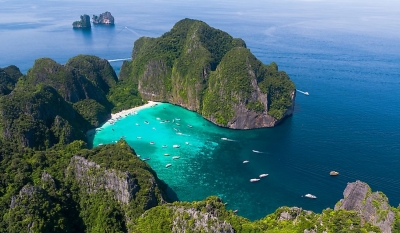
A bay is a body of water partially surrounded by land. A bay is usually smaller and less enclosed than a gulf. The mouth of the bay, where meets the ocean or lake, is typically wider than that of a gulf.
In naming bays and gulfs, people have not always made these distinctions. The Persian Gulf, for example, is much smaller than Hudson Bay, Canada.
Bays can also be called lagoons, sounds, and bights. Lagos, the capital of Nigeria, is a bayside city. It sits on Lagos Lagoon, on the Bight of Benin, in the Gulf of Guinea, in the Atlantic Ocean.
Bays form in many ways. Plate tectonics, the process of continents drifting together and rifting apart, causes the formation of many large bays.
The Bay of Bengal, the largest bay in the world, was formed by plate tectonics. Millions of years ago, the Indian subcontinent crashed—and continues to crash—into the the massive Eurasian plate network. The Indian plate is subducting beneath the small Burma plate, forming the Sundra Trench. Because plate tectonics remain an active force in the Bay of Bengal today, the region is home to underwater earthquakes and tsunamis.
Bays are also formed when the ocean overflows a coastline. Kowloon Bay, Hong Kong, was formed as the South China Sea overflowed the coastline of the Kowloon Peninsula. Today, Kowloon Bay has been almost entirely reclaimed from the sea. Kowloon Bay is a major industrial and financial area, and was home to Hong Kong’s airport until a new facility was built in 1998.
Another well-known coastal bay is New York Bay. New York Bay is actually two bays (Upper New York Bay and Lower New York Bay) connected by a strait called The Narrows. New York Bay is where the Hudson River meets the Atlantic Ocean.
Many bays are formed as the coastline erodes into the ocean. Guanabara Bay, for example, was formed as the Atlantic Ocean eroded an inlet in South America. Today, Guanabara Bay, also known as the Harbor of Rio de Janerio, Brazil, is one of the Seven Natural Wonders of the World.
A type of bay known as a ria is actually an estuary that has been taken over by the ocean. (An estuary is the mouth of a river.) Rias are often called “drowned rivers.” Chesapeake Bay, on the East Coast of the United States, is one of the world’s largest rias. It is the drowned mouth of the Susquehanna River.
Fjords are narrow bays formed by glaciers. A glacier slices through the bedrock of an area, leaving a long, steep canyon when it recedes. The sea seeps into the inlet, forming a fjord.
Bays can also be found along the shores of lakes. Georgian Bay, for example, is a prominent bay in Lake Huron, one of North America’s Great Lakes. Georgian Bay is located in Ontario, Canada.
Freshwater Bay is a bay on the Swan River, near the busy urban area of Perth, Australia. Freshwater Bay has been a center of trade and transportation along the river for centuries.
Credit : National Geographic
Picture Credit : Google




